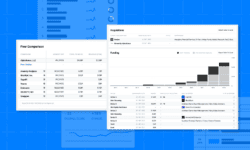In the oil and gas markets, both Wall Street and Main Street participants float in volatile waters.
Cyclical cross-currents can whip market direction 180 degrees in a nanosecond. Meanwhile, big structural waves routinely rise up, seemingly from nowhere, often underappreciated by market observers until it’s too late.
Understanding how companies are reacting to volatility signals has big implications for investors, suppliers, customers, and anyone else with an interest in this space. You’re likely familiar with how macro commodity price trends impact oil and gas companies. That said, volatility in this industry extends well beyond macro oil and natural gas price cycles.
Dozens of “micro-markets” exist across the oilfield. Each one can be a source of hidden and surprising volatility for companies in the space and for their investors. Monitoring management commentary on these micro-volatility drivers in a smart, real-time fashion is critical to understand how various companies are positioning themselves around cross-currents.
At present, the big driver of micro-volatility in the oil industry is a temporary constraint: insufficient Permian Basin takeaway capacity. Here is the situation:
- The Permian Basin in Texas is the largest oilfield in the world today as measured by rigs working in a single basin.
- All of these rigs are pushing oil production up faster than in-place pipelines can take it away to end markets (think of it as the Texas oil industry overheating).
- As a result, it’s necessary for a large amount of oil (more than producers would like) to stay in the ground until pipeline construction catches up to the drilling rigs unlocking West Texas crude (sometime next year).
Boiling it all down to company implications, this means that surface activity might have to slow its torrid growth curve for the next 6-12 months. This potential slow-down has caused a huge amount of hand wringing on Wall Street during the summer of 2018. Crude oil originating in the Permian Basin has traded at a discount of almost $20 per barrel this year.
To be sure, this issue is a temporary one; however, equities have been crushed over the past few months on fears of a slow-down. Oilfield supplier management teams are getting nervous about the implications too.
During 1Q18 earnings season, research in AlphaSense revealed that Permian takeaway commentary factored heavily into earnings calls. During 1Q18, the oil producers’ message was one of reassurance. Permian oil companies acknowledged the issue as being the question they get most often from their investors, but most said it wouldn’t impact them. They were keeping their feet on the gas pedal and taking the position that “someone else will cut.”
In short, the oil companies have set a high bar with their comments to investors so far this year. With 2Q18 earnings season underway, the story will be different for some. The most sophisticated producers have negotiated agreements to move their barrels, but lesser firms may have to own up to constraints on conference calls this quarter. In fact, some already have.
Smaller operators who don’t have the contracting clout and the marketing surety that the big companies are touting are more likely to struggle because it’s harder for them to get attention and get pipeline space given their scale.
While temporary in nature, Permian differentials continue to be the primary source of volatility on most oil industry observers’ screens today. As Q2 earnings season continues, more critical information for understanding how the industry and specific players in it will react to this near-term concern will come to light.
Joseph Triepke is Founder and Principal Research Analyst at InfillThinking.com, an oilfield market information firm. Previously, he was a publishing sellside analyst and a buyside analyst working on oilfield service names for firms including Citadel, Guggenheim, and Jefferies. He majored in finance at the University of Texas at Austin.




